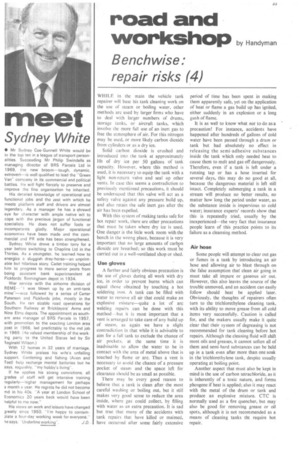road and
Page 35

If you've noticed an error in this article please click here to report it so we can fix it.
workshop by Handyman
Benchwise: repair risks (4)
WHILE in the main the vehicle tank repairer will base his tank cleaning work on the use of steam or boiling water, other methods arc used by larger firms who have to deal with larger numbers of drums, storage tanks, or aircraft tanks, which involve the more full use of an inert gas to free the atmosphere of air. For this nitrogen may be used, or more likely carbon dioxide from cylinders or as a dry ice.
Solid carbon dioxide is crushed and introduced into the tank at approximately lib of dry ice per 50 gallons of tank capacity. However, where this method is used, it is necessary to equip the tank with a light non-return valve and seal up other vents. In case this seems a contradiction to previously mentioned precautions, it should he unders4pod that this valve will act as a safety valve against any pressure build up, And also retain the safe inert gas after the air has been expelled.
With this system of making tanks safe for hot repair work, there are other precautions that must be taken where dry ice is used. One danger is the little work room with the bench in the wrong place, because it is very important that no large amounts of carbon dioxide are breathed; so this work must be carried out in a well-ventilated shop or shed.
Use gloves
A further and fairly obvious precaution is the use of gloves during all work with dry ice, in order to prevent burns which can equal those obtained by touching a hot soldering iron. A tank can be filled with water to remove all air that could make an explosive mixture—quite a lot of arc welding repairs can be done with this method—but it is most important that a vent is arranged to take care of any build up of steam, as again we have a slight contradiction in that while it is advisable to aim for a full tank to exclude the chance of air pockets, at the same time it is inadvisable to allow the water to be in contact with the area of metal above that is touched by flame or arc. Thus a vent is necessary to avoid the chance of a pressure pocket of steam and the space left for clearance should be as small as possible.
There may be every good reason to believe that a tank is clean after the most careful washing or boiling out, but it still makes very good sense to reduce the area inside, where gas could collect, by filling with water as an extra precaution. It is sad but true that many of the accidents with tank repairs that have killed or maimed, have occurred after some fairly extensive
period of time has been spent in making them apparently safe, yet on the application of heat or flame a gas build up has ignited, either suddenly in an explosion or a long gush of flame.
It is as well to know what not to do as a precaution! For instance, accidents have happened after hundreds of gallons of cold water have been passed through a drum or tank but had absolutely no effect in releasing the semi-adhesive substances inside the tank which only needed heat to cause them to melt and gas off dangerously. Therefore, even if a tank is left under a running tap or has a hose inserted for several days, this may do no good at all, because the dangerous material is left still intact. Completely submerging a tank in a stream will produce no better results, no matter how long the period under water, as the substance inside is impervious to cold water; insurance experts' records show that this is repeatedly tried, usually by the inexperienced—the very fact that insurance people learn of this practice points to its failure as a cleansing method.
Air hose
Some people will attempt to clear out gas or fumes in a tank by introducing an air hose and allowing air to blast through on the false assumption thaf clean air going in must take all impure or gaseous air out. However, this also leaves the source of the trouble unmoved, and an accident can easily follow should heat be applied later. Obviously, the thoughts of repairers often turn to the trichlorethylene cleaning tank, with its ability to move grease from all cold items very successfully. Caution is called for, and the makers usually make it quite clear that their system of degreasing is not recommended for tank cleaning before hot repairs. Although the cleaning fluid will shift most oils and greases, it cannot soften all of them and semi-hard substances can be held up in a tank even after more than one soak in the Irichlorethylene tank, despite usually operating at boiling point.
Another aspect that must also be kept in mind is the use of carbon tetrachloride, as it is inherently of a toxic nature, and forms phosgene if heat is applied; also it may react with the metal of the drum or tank and produce an explosive mixture. CTC is normally used as a fire quencher, but may also be good for removing grease or oil spots, although it is not recommended as a means of cleaning tanks tht require hot repair.




































































































